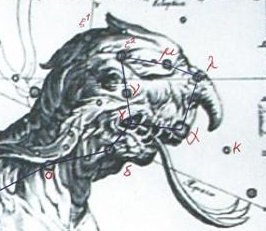From Sirius (Ca4-25) up to and including Cb1-6 (398) there were 299 glyphs:
There were 100 days from Algenib Pegasi to Sirius, and there were also 100 days from the Pale star in Crux to the South Dipper, presumably referring to φ Sagittarii.
North of the equator these 100 days (and glyphs) represented the first part of the year beyond the spring equinox and south of the equator they represented the first part of the year beyond the end of summer. I have suggested the Southern Cross with Raven was to be read at the beginning of the text. 100 glyphs later would then have been at the South Dipper with Sirius close to the Full Moon in December 30. These 100 glyphs could be like a reflection of those 100 days which north of the equator began at spring equinox and ended at heliacal Sirius in June 30. The cycle of time went beyond day 365 and at heliacal Polaris was April 16 (472 = 8 * 59). The following day was April 17 (107 + 366 = 473) with the First Point of Aries (Sheratan, β Arietis, the Front of the Head of Ku, Mahrū-sha-rishu-ku). North of the equator it was spring once again. The corresponding season south of the equator began in day 290 (October 17), when the Sun reached Muphrid (the Solitary star, η Bootis). 107 (April 17) + 183 = 290 (October 17).
In rongorongo times Sheratan rose with the Sun 27 days after 0h. In Roman times Sheratan would have been at 0h. The precession pushed the stars ahead in the year. 5 days after Sheratan was ξ╣ Ceti:
It seems as if the rising Sun in spring north of the equator was pushing his head up from the waters of winter and as if the rising Sun in spring south of the equator was climbing up a hill.
... Mons Maenalus, at the feet of Bo÷tes, was formed by Hevelius, and published in his Firmamentum Sobiescianum; this title coinciding with those of neighboring stellar groups bearing Arcadian names. It is sometimes, although incorrectly, given as Mons Menelaus, - perhaps, as Smyth suggested, after the Alexandrian astronomer referred to by Ptolemy and Plutarch. The Germans know it as the Berg Menalus; and the Italians as Menalo. Landseer has a striking representation of the Husbandsman, as he styles Bo÷tes, with sickle and staff, standing on this constellation figure. A possible explanation of its origin may be found in what Hewitt writes in his Essays on the Ruling Races of Prehistoric Times: The Sun-god thence climbed up the mother-mountain of the Kushika race as the constellation Hercules, who is depicted in the old traditional pictorial astronomy as climbing painfully up the hill to reach the constellation of the Tortoise, now called Lyra, and thus attain the polar star Vega, which was the polar star from 10000 to 8000 B.C. May not this modern companion constellation, Mons Maenalus, be from a recollection of this early Hindu conception of our Hercules transferred to the adjacent Bootes? May not this painful climbing up the mother-mountain from 71 (= 26000 / 366) Virginis towards Vega have inspired the 2nd climbing bird (manu kake rua) in the center of the week once having begun in oJULY 22 (22-7, π)?
Although Vega would no longer be the goal but rather Polaris. 14 * 26 (at manu kake rua) = 364 and in Roman times Polaris was rising with the Sun in 'March 20 (*364). *364 - *179 ('September 16) = 185. |
||||||||||||||||||||||||||||||||||||||||||||||||||||||||||||||||||||||||||||||||||||||||||||||||||||||||||||||||||||||||||||||||||||||||||||||||||||||||||||||||||||||||||||||||||||||||||||||||||||||||||||||||||||||||||||||||||||||||||||||||||||||||||||||||||||||||||||||||||||||||








